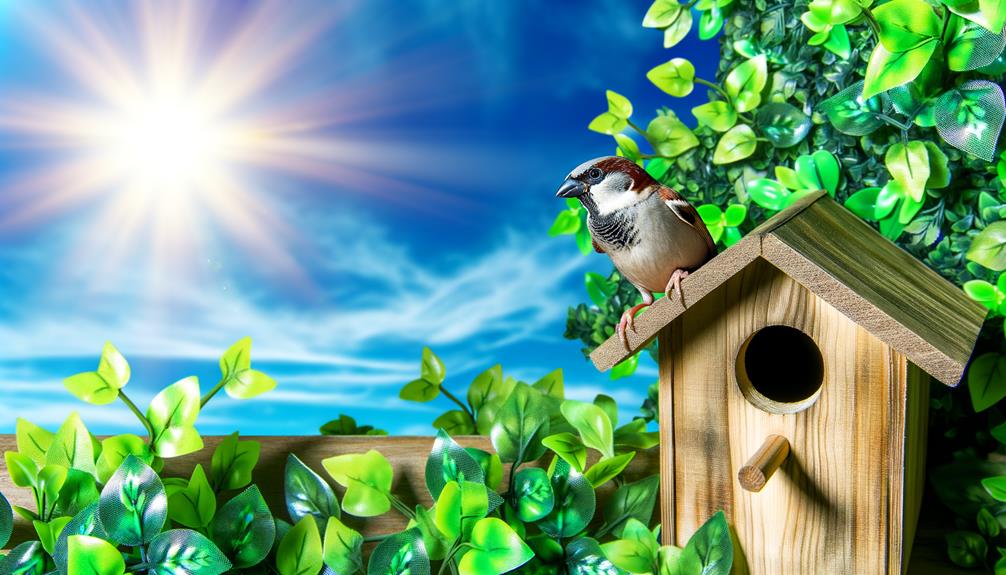Common Bird House Sparrow Characteristics?
The house sparrow is a universal bird, celebrated for its adaptability. It's both predator and prey, aiding in controlling insect populations and acting as a food source for larger creatures.
Primarily, they're granivorous, eating grains and seeds but their diet also includes insects, kitchen scraps, and fruits. Dwelling in diverse environments, they find homes in urban settings, open woodlands, and farmlands.
With a distinctive look, males sport black bibs and white cheeks. Exhibiting social behavior, they thrive in flocks.
Discovering more about these intriguing birds allows one to deepen their understanding on their significant role in our ecosystems.

Key Takeaways
- The House Sparrow is a small bird, typically measuring 14-18 cm, with distinctive black bibs and white cheeks on males.
- Primarily granivorous, House Sparrows consume grains and seeds, supplemented with insects, fruits, and even human food waste.
- This bird species is globally distributed, adapting to diverse environments including urban settings, open woodlands, and farmlands.
- House Sparrows are gregarious and often found in flocks, with a rapid breeding capability producing several broods per year.
- They play an important role in ecosystems, acting as both predator and prey, controlling insect populations, dispersing seeds, and maintaining ecological balance.
Understanding the House Sparrow
Diving right into the heart of the matter, the House Sparrow, often overlooked, plays a significant role in our urban ecosystems and its understanding requires a meticulous observation of its unique habits and characteristics.
It's a species that thrives alongside humans, brightening cities with their chirping. The bird's adaptability to urban environments is particularly remarkable. They've successfully colonized a wide range of habitats, from parks to gardens, and even bustling city centers.
They're a perfect example of a commensal species, one that benefits from human activities without causing any significant harm. Understanding the House Sparrow isn't simply about appreciating a common bird, it's about recognizing the intricate relationship between wildlife and urban environments.
Characteristics of the House Sparrow
Having appreciated their role in urban ecosystems, it's equally interesting to explore the distinct traits of the House Sparrow, which contribute to their remarkable adaptability.
Some of these characteristics include:
- Distinctive Appearance: Males are easily recognizable with black bibs, white cheeks, and brown napes. Females are duller, with a plain buff breast and brown streaks.
- Size and Weight: They're small birds, typically measuring between 14-18 cm in length, and weighing between 24-39.5 grams.
- Diet: House Sparrows are omnivorous, feeding on seeds, fruits, insects, and human food waste.
- Social Behavior: They're gregarious birds, often found in flocks, and are non-migratory.
- Breeding: They breed rapidly, with each pair capable of producing several broods per year.
These characteristics contribute to their resilience in diverse environments, making them one of the most widespread bird species.
House Sparrow's Habitat and Distribution
The House Sparrow's impressive adaptability is clearly demonstrated in its broad habitat range and global distribution, with the species thriving in diverse environments from bustling cityscapes to serene countryside locales. Originally a Eurasian and North African bird, it has successfully colonized every continent except Antarctica.
It's a versatile species that has a knack for exploiting human-made structures, often nesting in crevices of buildings and other urban settings. Despite this, they're not strictly tied to human settlements, also inhabiting open woodlands, hedges, and farmlands.
However, their numbers have been declining in their native range due to urbanization and changes in farming practices. These shifts highlight the House Sparrow's delicate balance between adaptability and environmental pressures.
Feeding Habits of House Sparrows
While the House Sparrow's adaptability is evident in its broad habitat range, it's equally apparent in its diverse feeding habits. These birds are primarily granivorous, but they don't limit themselves to seeds. They exhibit a level of opportunism when it comes to food, adapting their diet according to availability.
- House Sparrows frequently consume grains and seeds.
- They supplement their diet with insects, especially during breeding season.
- Kitchen scraps, fruits, and vegetables are also part of their diet.
- They can be seen foraging in trash bins in urban environments.
- Occasionally, they also prey on small vertebrates.
These varied feeding habits not only demonstrate their adaptability, but also their significant impact on the environment, a topic we'll explore in the next section.
The Role of House Sparrows in Ecosystems
In ecosystems around the world, house sparrows play a pivotal role, acting as both predator and prey in the food chain. As predators, they consume insects, thereby controlling their population and preventing infestations. This is particularly beneficial in agricultural ecosystems where unchecked insect populations can destroy crops.
As prey, they provide a food source for larger birds and mammals, contributing to the survival and health of these species.
Moreover, house sparrows are also important dispersers of seeds. They consume seeds, but not all are digested. Some are expelled in different locations, aiding in plant propagation. This helps maintain plant diversity and contributes to the overall balance of ecosystems.
Consequently, the seemingly humble house sparrow holds a significant position in maintaining ecological stability.
Conclusion
So, next time you spot a house sparrow, don't just dismiss it as another bothersome bird. These small personalities are true survivors, thriving in an ever-evolving world.
They're gobbling up bugs, distributing seeds, and essentially managing their own little birdie ecosystem service.
So let's give a chirpy cheer for our feathered friends, the house sparrows, because without them, we'd be knee-deep in pests and missing the simple joy of their delightful chirping.






